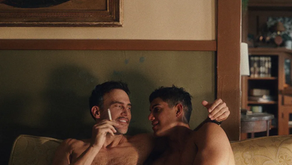Movies: Diamanti (2024) by Ferzan Özpetek: A Celebration of Sisterhood in Rome's 70s Couture
- dailyentertainment95

- 3 hours ago
- 9 min read
A Tapestry of Female Lives in a Roman Atelier
The film is a celebrated, multi-award-winning Italian drama-comedy by Ferzan Özpetek, set between contemporary times and a 1970s Roman tailoring shop, focusing on female relationships and artistic craft.
Diamanti is a drama-comedy by the acclaimed Italian-Turkish director Ferzan Özpetek. The film, set primarily in a prestigious Roman tailoring shop in the 1970s, interweaves the professional and personal lives of the women who work there. It is framed by a meta-narrative in the present day, where a director (played by Stefano Accorsi) calls his favorite actresses, including stars like Luisa Ranieri and Jasmine Trinca, to cast them in a female-centric film set in the past. This celebration of femininity, sisterhood, and the craft of costume design has earned it significant accolades, notably 8 wins & 2 nominations total, including the prestigious Nastri d'Argento Award for Film of the Year.
Why to Watch This Movie: The Allure of Ensemble and Emotion
The film is highly recommended for its stellar ensemble cast, the director's unique emotional style, a stunning celebration of artistic craft, and its capacity to evoke both laughter and tears.
Why to recommend movie: An Artistic Feast of Emotion, Sisterhood, and Style
A Stellar Ensemble Cast (The Diamonds):
The film features a magnificent collective of Italian actresses ("the diamonds"), with Luisa Ranieri and Jasmine Trinca leading as the two sister-owners, Alberta and Gabriella. The performances are lauded for their chemistry and depth, bringing a compelling sense of camaraderie to the screen. The script allows a large cast of characters to each shine, making the collective story as powerful as the individual ones.
Özpetek's Signature Style:
Fans of Ferzan Özpetek will recognize his touch: a vibrant blend of comedy and drama, an intimate focus on complicated human relationships, especially among women, and a maximalist visual aesthetic, often involving elaborate food and gatherings. His direction creates a dynamic and emotionally rich environment.
Celebration of Craft and Nostalgia:
The movie is a visual feast, paying homage to the artistry of 1970s Roman cinema, haute couture, and costume design, particularly referencing the style of legendary costumers. The authentic setting of the sartoria (tailoring shop) and the intricate work of the seamstresses (the "diamonds" of the title) are central to the film's beauty and narrative.
Emotional Resonance and Depth:
While lighthearted at times, the film tackles heavy themes like grief, domestic abuse, professional ambition, and the strength found in female solidarity. It's described as a film that will make the audience "belly laugh and cry," offering a genuine emotional payoff.
Where to watch: https://www.justwatch.com/es/pelicula/diamonds-2024 (Spain)
Link IMDB: https://www.imdb.com/title/tt32810496/
Link Review: https://cineuropa.org/en/newsdetail/471522/
About movie: https://www.greenboo.com/film/diamanti/
What Trend is Followed? The Resurgence of the Female-Centric Ensemble
The film follows the trend of "female driven" cinema by prioritizing female-centric narratives, showcasing a large ensemble of women and using meta-cinematic techniques to blend reality and fiction.
What is the Trend followed: Empowering, Women-Led Ensemble Dramas
Female-Centric Narratives: The film firmly aligns with the trend of cinema that places women at the forefront, focusing entirely on their struggles, successes, and relationships. It’s a dedicated tribute to the lives of women, particularly those whose work may be overlooked or trivialized.
The Ensemble "Female Driven": The story is structured around a large cast of female characters from all walks of life—sisters, seamstresses, an Oscar-winning costume designer, and actresses—whose varied personal dramas are interwoven with the main plot, showcasing a powerful and complicated sisterhood.
Meta-Cinematic Framing: The use of a director (Özpetek's alter-ego) breaking the fourth wall and interacting with the actresses in the present day before they become their 1970s characters is a contemporary trend in auteur cinema, blending reality and fiction to reflect on the creative process itself.
Movie Plot: The Drama Woven into the Fabric
The plot centers on the high-pressure work and complex personal lives of the sisters and seamstresses running a prestigious Roman tailoring house in the 1970s, framed by a modern-day casting session.
Plot Summary: Rivalry, Resilience, and Romance in a 70s Tailoring House
The film unfolds on two planes: a contemporary frame story and the main narrative set in 1970s Rome.
A film director (Stefano Accorsi) gathers his favorite Italian actresses to propose a film about a prestigious tailoring house run by women in the 1970s.
The main plot revolves around the Canova sisters, Alberta (Luisa Ranieri), the strict and business-savvy backbone, and the more vulnerable Gabriella (Jasmine Trinca), who is still grieving the loss of her young daughter.
The atelier is staffed by a group of colorful, resilient seamstresses, each with a complex personal life and hidden burdens:
One endures a violently abusive husband.
Another is a single mother dealing with her depressed son.
They work on elaborate costumes for film and theater, navigating high-stakes professional dramas, especially with demanding clients like an Oscar-winning costume designer, Bianca Vega (Vanessa Scalera).
The drama is enriched by subplots concerning love, loss, and professional ambition, all set against a backdrop of vibrant colors, fabrics, and the intense camaraderie of the women's workplace. The central theme is how these women, like diamonds, are forged under immense pressure and find unbreakable strength in their solidarity.
Director's Vision: Özpetek's Affection for His Muses
Özpetek's vision is a deeply personal, nostalgic homage to his actresses and the women of his youth, using a maximalist style to blur the lines between cinematic art and lived memory.
Director's Vision: A Poetic and Personal Homage to Women
Personal and Nostalgic: The film is partially autobiographical, rooted in Özpetek's own memories as a young assistant director in Rome, frequenting the city's lively costume tailor shops. He approaches this period with reverence for the women and the art of costume-making.
Praise for His Actresses: Özpetek uses the meta-cinematic device of the director gathering his "muses" to openly convey his deep professional affection and admiration for the actresses he has worked with throughout his career.
Blending Reality and Fiction: His vision deliberately blurs the line between the actresses' contemporary lives and the characters they portray in the 1970s, suggesting that these stories of female resilience and creativity are a shared, timeless memory.
Maximalist and Emotional: He creates a "sweeping and epic" feel even in confined locations, using dynamic camera movement, a vibrant aesthetic, and a memorable soundtrack featuring classic Italian songs to amplify the emotional journey of the characters.
Themes: Sisterhood, Resilience, and the Art of Creation
Key themes emphasize female solidarity as a source of power, celebrating women's resilience in the face of struggle, the high art of costume design, and the interplay between life and storytelling.
Themes: The Power of Female Solidarity and Creative Endeavor
Sisterhood and Solidarity: The primary theme is the unbreakable bond and camaraderie among the women in the workshop. Their noisy, sarcastic, yet deeply caring relationships are the emotional heart of the film, highlighting how they support each other through personal crises.
Female Resilience and Power: The women—the "diamonds"—are portrayed as strong, multifaceted, and resilient, capable of enduring immense pressure (domestic abuse, grief, professional stress) while creating great art. The film celebrates their strength and power in a male-dominated industry.
The Art of Costume Design: The film is a passionate homage to the craft of costume-making, showing the detail, skill, and passion involved in creating the magnificent garments for film and opera. This creative endeavor provides a sanctuary and a source of shared purpose.
Reality vs. Fiction: The narrative's framework constantly plays with the idea of memory, filmmaking, and storytelling, exploring how the lines between the life of an actor/director and the story they create become blurred and interwoven.
Key Success Factors: Critical Acclaim and Audience Love
The film's success is driven by its strong cast chemistry, visual authenticity, the director's deft handling of genres, and its high popularity, reflected by its strong box office and Audience Award win.
Key success factors: An Acclaimed Cast, Director's Style, and Emotional Storytelling
Authenticity and Detail: The film achieves a sense of truth by grounding its setting in real-life influences from Rome's costume design history and focusing on authentic details of the seamstresses' work, which lends credibility to the workplace drama.
Box Office and Popularity: It achieved significant commercial success, grossing $19,542,905 worldwide and being noted as the most-watched Italian film in cinemas for its release year. It won the special Audience Award at the David di Donatello awards, confirming its popular appeal.
Strong Ensemble Chemistry: The palpable chemistry among the star-studded ensemble cast is a major draw, with each actress delivering a memorable and harmonious performance, essential for a film with so many interwoven storylines.
Effective Blending of Genres: Özpetek deftly walks a tonal tightrope, balancing moments of high comedy with profound tragedy and intense drama, a style that resonates strongly with audiences.
Awards & Nominations: A Critically Decorated Gem
The film is a major Italian award winner, securing the top critical honor (Nastri d'Argento Film of the Year) and the public's choice (Audience David), highlighting both critical and popular acclaim.
Awards & Nominations: Recognition from Critics and Audiences Alike
The film has received 8 wins & 2 nominations total. Most notably, it was honored with the prestigious Nastri d'Argento Award for Film of the Year, a title voted on by Italian film critics and journalists. It also won the Audience David at the David di Donatello Awards, demonstrating both critical and popular appreciation.
Critics Reception: A Dazzling Yet Divisive Spectacle
Critics praised the film's emotional power, stunning visuals, and ensemble performances, but some critiques centered on the director's meta-framing, which was seen as potentially overshadowing the women's narratives.
Critics Reception: A Mixed Bag of Praise for Emotion and Critique of Self-Focus
Perth Happenings: Praises the film as a "heartwarming celebration of women" and a "crowd-pleaser." It highlights the strong emotional impact, the stunning costumes and 70s fashion, and the loud and clear message: "We are nothing but we are everything" (strength in unity).
Film Ireland: Expresses disappointment, arguing the film "falls short" of recent Italian feminist cinema. The review critiques the director for commandeering the first scene and frequently inserting himself, which "stifles" the women's stories, making the project feel like a "performative act."
Sarah G. Vincent Views: Notes the film's success in creating a "dynamic film" that juggles many narrative elements, praising the powerful performances and the "genuine emotional payoff." However, it points out the irony that a film celebrating women is helmed by men (director and co-writers) and calls it a "missed opportunity" to hire more women behind the camera.
Stage and Cinema: Finds the film "entertaining ride well worth the watch," admiring its luminous cinematography, refined sets, and the superb, seamless ensemble acting. It notes the director's deep affection for women and the film's poetic atmosphere, though suggests the finale is "anti-climactic."
Overall Summary: Critics are divided but largely agree on the film's strengths: the compelling, star-studded ensemble cast; the emotional richness; the visual feast of costumes and setting; and the director's heartfelt intention to celebrate women. The main criticism centers on the meta-narrative, with some feeling the director's presence and focus on his "muses" detracts from the depth of the characters' individual struggles, labeling it a flawed but ultimately dazzling spectacle.
Reviews: Audience Cheers for Passion and Artistry
Audience reviews are overwhelmingly positive, praising the film's artistic quality, emotional intensity, and its powerful representation of female empathy and love, though a small minority found it unengaging.
Overall Summary: Audience reception, as reflected in the IMDb reviews and the Audience Award win, is highly positive. Viewers especially connected with the film's emotional depth, the theme of female empowerment, the quality of the acting, and the overall artistry and passion of the production. The general consensus is that it is a touching and highly engaging cinematic experience.
Movie Trend: Meta-Narratives and the Auteur's Self-Reflection
The film embodies the cinematic trend of the auteur's self-reflection, using a meta-narrative structure (a film-within-a-film) to personally honor his creative muses and the filmmaking process.
Movie Trend: The Director's Meta-Reflection
The film distinctly follows a growing trend where established auteurs incorporate a meta-narrative—a story about making a story—to reflect on their own careers, muses, and the nature of filmmaking. By casting himself and his favorite actresses in the present before transitioning to the 1970s fictional plot, Özpetek engages in self-referential cinema, turning the film into a personal statement and a love letter to his collaborators.
Social Trend: The Continuing Push for Female Representation and Empowerment
The film aligns with the major social trend of celebrating female empowerment and creative labor by placing women's stories, solidarity, and careers at the absolute center of the narrative.
Social Trend: Female Empowerment and the "Women at Work" Narrative
Diamanti directly taps into the powerful and ongoing social trend of female empowerment and the celebration of women's work, both in the public eye and behind the scenes. By setting the main plot in a workplace run and populated by women with marginal roles for men, the film champions women's autonomy, solidarity, and creative contributions. It gives voice to the private struggles (like domestic violence) and triumphs of working women, aligning with a demand for diverse and complex female representation in media.
Final Verdict: A Flawed but Flamboyant Ode to Women
Despite some critical division over its meta-framing, the film is ultimately a highly recommended, moving, and visually rich success, characterized by strong ensemble performances and a powerful tribute to female resilience.
Final Verdict: A Cinematic Gem Forged by Friendship and Passion
Diamanti is a classic Ferzan Özpetek film: visually rich, emotionally resonant, and brimming with the energy of a powerful ensemble cast. While the meta-narrative framing and self-referential elements are a point of critical debate, its core—a passionate, moving tribute to the resilience, creativity, and sisterhood of women—is an undeniable success. Bolstered by a magnificent cast and a gorgeous 1970s aesthetic, it is a highly recommended and acclaimed theatrical experience.
Similar Movies: Films That Celebrate Sisterhood and Creative Passion
The film shares thematic and structural similarities with celebrated ensemble films focusing on women, emotional bonds, and artistic workplaces.
A Cinematic Family Tree of Ensemble and Emotion
Steel Magnolias
The Women (1939)
Loose Cannons (A previous Özpetek film, Mine Vaganti, sharing themes of family and ensemble drama)
The Goddess of Fortune (Another Özpetek film focusing on complex relationships and ensemble casts)
Phantom Thread (Shares the setting and focus on a high-stakes tailoring/fashion house)









Comments